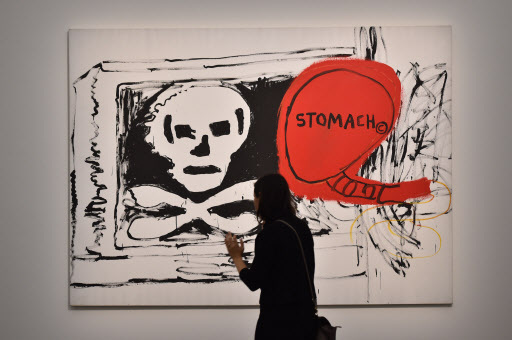MILAN (AFP) -- New York’s Eighties art scene is coming to Milan with a show dedicated to the late Haitian-American artist Jean-Michel Basquiat, whose works now sell for phenomenal sums.
From his child-like skull and crown paintings to his poetic and enigmatic anatomical depictions, the Museum of Culture in the north Italian city is holding a retrospective until February into the works of the art prodigy, who died from a drug overdose aged just 27.
Born in 1960 in Brooklyn to a Haitian father and Puerto Rican mother, the young, handsome Basquiat became one of the most celebrated and influential artists of his generation, leaving more than 2,000 drawings or paintings.
“Basquiat conquered the world” with his “genius,” said Gianni Mercurio, who co-curated the exhibition with Jeffery Deitch, who had been one of the painter’s friends.
The retrospective, which runs near chronologically, exhibits works executed between 1980 and 1987, largely on loan from the private collection of prominent New York art dealer Jose Mugrabi, who also knew Basquiat.
Some 140 paintings, drawings and ceramics await visitors, from street art to the youngster’s collaboration with pop art master Andy Warhol, who he met and formed a close relationship with in 1980.
Basquiat, who was a regular museum-goer as a child but dropped out of school at 16, first rose to prominence in the 1970s with graffitied statements across SoHo, done with friend Al Diaz and signed “SAMO” (“same old, same old bullshit”).
His work then began to evolve into colorful paintings, using acrylics, oils, pastels and creating collages on paintings, tables or doors.
 |
A woman visits the exhibition “Jean-Michel Basquiat,” a retrospective on Jean-Michel Basquiat’s career from graffiti in New York to more complex work, at the Mudec Museum in Milan on Thursday. (AFP-Yonhap) |
Many of his creations feature words and have been described as bridging traditional tribal art and socio-political missives.
Pride and anger
His friendship with Warhol would mark him forever.
“The relationship between Warhol and Basquiat was a very close one: Basquiat regarded Warhol as his spiritual father, and Warhol saw in Basquiat the son he never had,” Mercurio told AFP.
But the fruits of their collaboration, exhibited in Zurich and New York, “met with a negative reaction in the press.”
“Some critics said it was a commercial ploy to revitalize Warhol and consolidate Basquiat’s success, others said Warhol did what he wanted with Basquiat, criticisms which deeply hurt the already fragile” New York artist, he said.
Basquiat broke off the collaboration but appeared to suffer his decision.
Warhol’s death in 1987 worsened his depression and his heroin addiction spiraled, leaving him dead a year later of an overdose.
“Basquiat was an artist full of contradictions. His personality was based on pride. He wanted to be a famous artist, not just a famous black artist,” said Mercurio.
“He said 80 percent of his work was done in anger. But at the same time, he was a sweet, hesitant person. His fragility came from his fear of losing his success from one moment to another,” he added.
He need not have worried: his paintings and drawings today regularly beat the expected price at auctions. Between July 2015 and June 2016 his works were sold for a total of $139.4 million, according to specialists Artprice.
And a new record was set in May at Christie’s in New York, with a huge self-portrait going for $57.2 million to a Japanese billionaire.
According to Artprice, between January 2000 and October 2016 the value of works of Basquiat rose a whopping 506 percent.








![[Today’s K-pop] Blackpink’s Jennie, Lisa invited to Coachella as solo acts](http://res.heraldm.com/phpwas/restmb_idxmake.php?idx=644&simg=/content/image/2024/11/21/20241121050099_0.jpg)